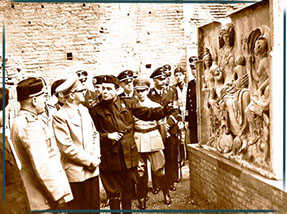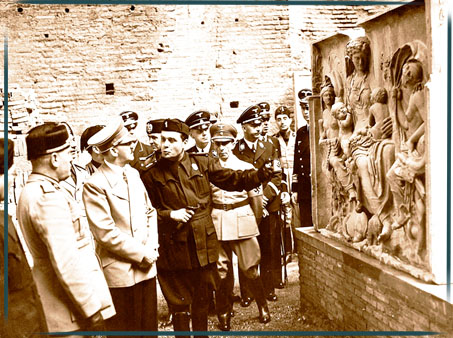
The first excavations were made in 1903 by Angelo Pasqui and Marianno Cannizaro, digging in the surrounding streets to rescue the pieces but without being able to access the parts located under the building's foundations. These excavations made it possible to know the staircases, total size and two accesses, but the difficulties of the aquifer caused that the project of recovery of the building was abandoned that same year.
It is necessary to wait until the historical season of Italian Fascism to re-raise the problematic of the excavations and recoveries of the ancient Roman monuments.
It was then under the political power of Benito Mussolini that the process of recomposing the altar dedicated to peace will begin.
"The peacekeeping capacity of Rome has been evoked by the vision of the Ara Pacis, the monument that fascism has wanted to recompose on the banks of the Tiber in all its beauty, with loving hand and attentive search..." Newspaper Holder on the day of the Reinauguration (National Geographic, Spain, http://WWW.NATIONALGEOGRAPHIC.COM.ES/HISTORIA/GRANDES-REPORTAJES/EL-ARA-PACIS-RESCATADA-DEL-SUBSUELO-DE-ROMA_7757/2, 09/03/2018)
In the time of Mussolini, in the bimillenary of the birth of the Roman emperor Augustus, he proposed to rebuild the Ara. For this, the Ara was under the Renaissance Palace Fiano-Almagia, but for this they encountered different natural oppositions as the amounts of mud to be under the groundwater that proposed a challenge to rescue the Parts of the Ara and which parts were distributed between the Vatican, Florence, Paris and Vienna.
The excavation started in 1937. In the same year began the recovery of the pieces by Giuseppe Moretti.
The difficult excavation process led to the need of lifting the Fiano castle so that it would not collapse. The recovery operation that followed was carried out thanks to a constructive strategy that consisted in creating a water dam of 70 meters in diameter and cooling the water to the freezing with liquid carbon dioxide that passed through a network of tubes. This gave access to the parts by eliminating the mud around and their next rescue to the light.
In 1937, the Uffizi Museum of the city of Florence was forced to deliver the reliefs that it had of the Ara and it was agreed with the pope the recovery of the fragment of the Vatican. The elements kept in Paris and Vienna, were never delivered and still remain as exhibitions in the museums.
The building had different locations: the first, after its discovery and reconstruction by Moretti was at the Musée de las Termas. From there he moved to a building built in three months next to the mausoleum of Augustus.
The ARA was inaugurated on September 23, 1938 by Mussolini as a commemoration of the two thousand years of the birth of the Emperor Augustus.
The building that currently protects and exhibits the Ara Pacis Augustae, was planned to be consistent with the environment and blended well with the urban landscape this building was in charge of Richard Meier.
ARA PACIS
RECONSTRUCTION











